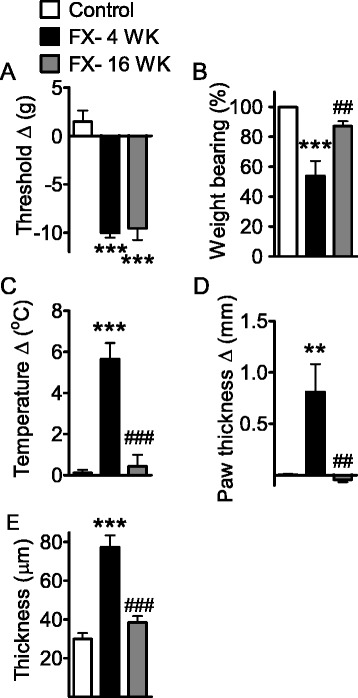Fig. 1.

Differential recovery of nociceptive and vascular abnormalities in the rat CRPS. The measurements displayed were made at 4 and 16 weeks after fracture. a Tibia fracture-induced mechanical allodynia to von Frey testing. b Hindpaw unweighting. c Hindpaw warmth. d Hindpaw edema. e Epidermal thickness. Measurements for a–d represent the difference between the fracture ipsilateral side and the contralateral paw. The values displayed in panel b represent weight-bearing on the fracture hindlimb as a ratio to 50 % of bilateral hindlimb loading. e Changes in dorsal hindpaw epidermal thickness at 4 and 16 weeks after fracture. Immunostaining of keratin (a keratinocyte marker) was performed in dorsal hindpaw skin sections from control rats (n = 7), and from the ipsilateral hindpaws of fracture rats at 4 (n = 8) and 16 weeks (n = 8) post injury. Data are analyzed to compare fracture at 4 weeks versus no-fracture control cohorts and fracture at 16 weeks versus fracture at 4 weeks cohorts using one-way analysis of variance (ANOVA) followed by Neuman-Keuls multiple comparison test. *P < 0.05, **P < 0.01, and ***P < 0.001, fracture at 4 weeks (panels a–d, n = 6) versus control rats (panels a–d, n = 6); # P < 0.05, ## P < 0.01, and ### P < 0.001, fracture at 16 weeks (panels a–d, n = 5) versus fracture at 4 weeks cohorts
